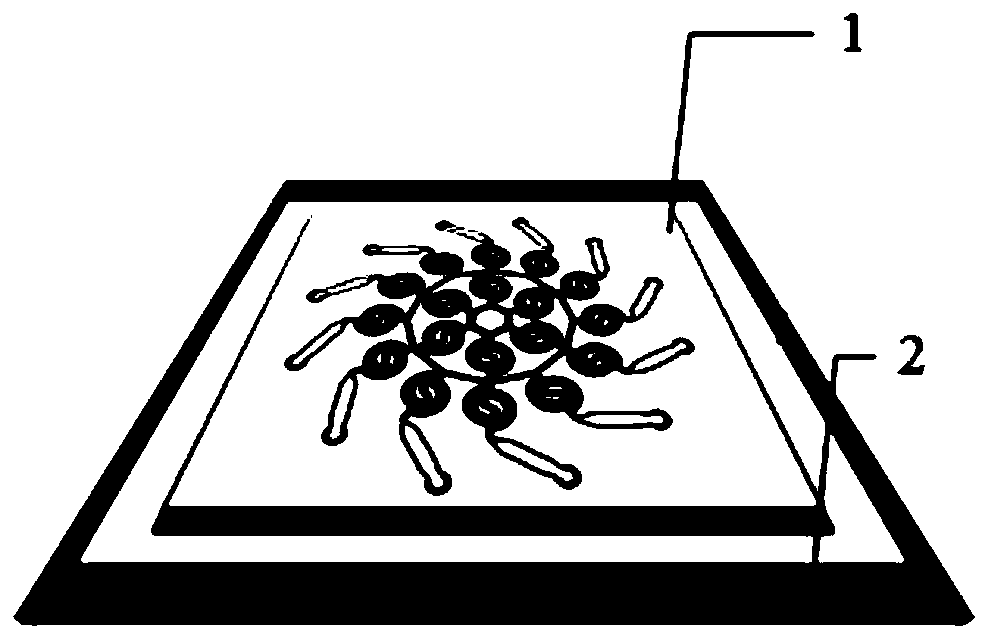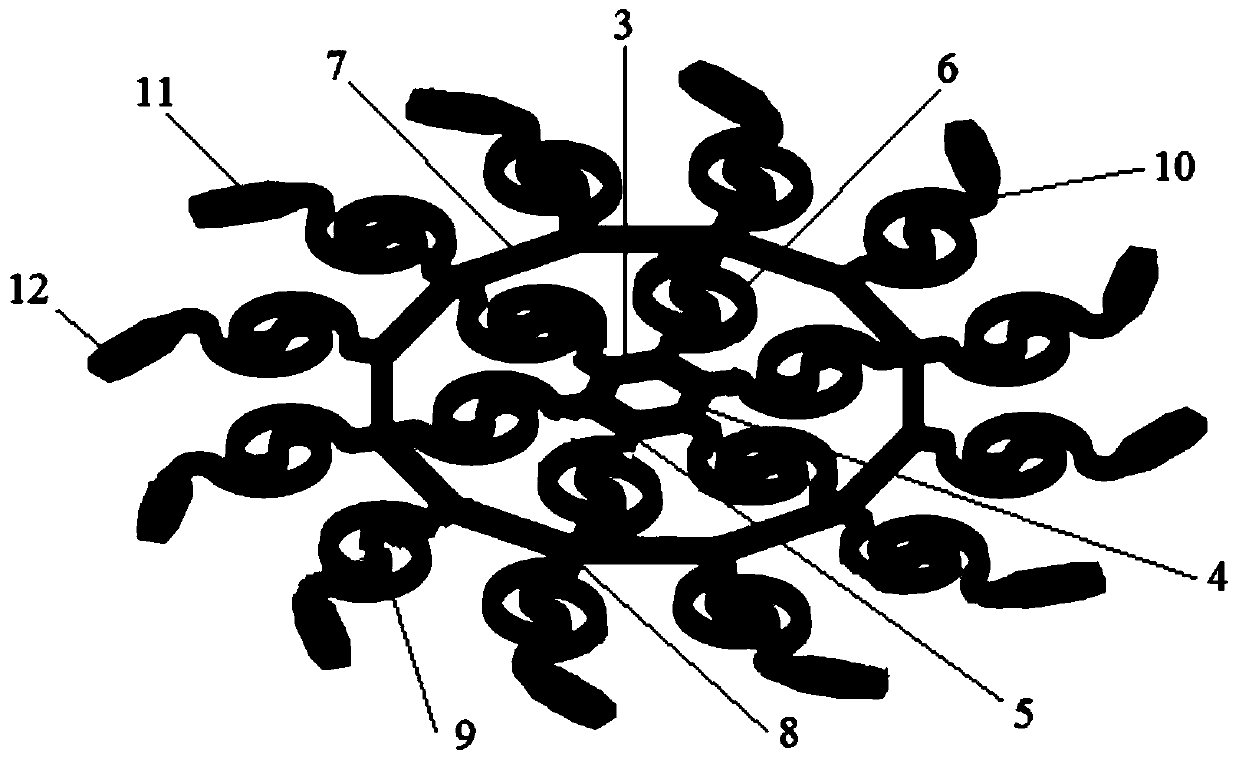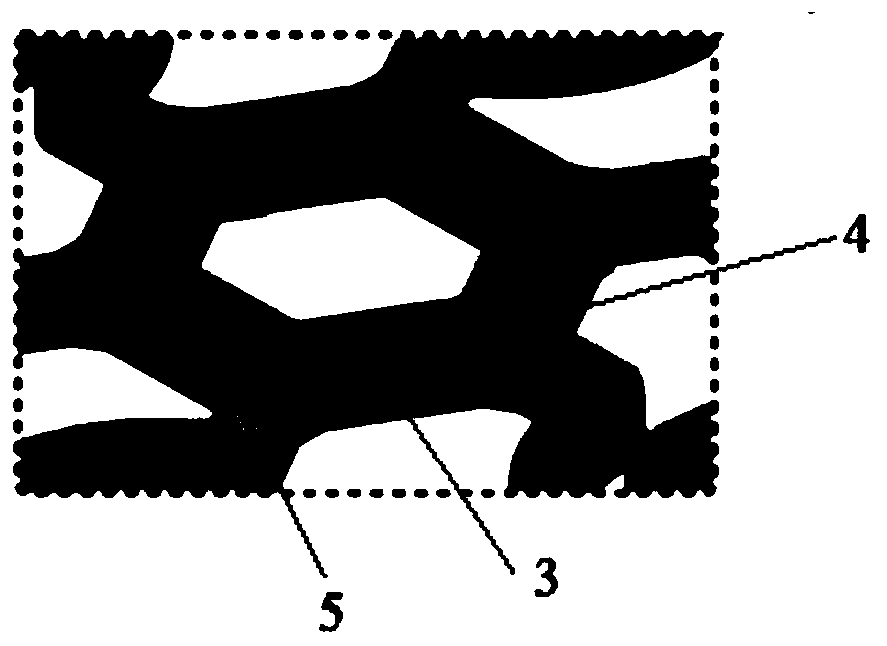Integrated microfluidic chip for drug screening and application thereof
A microfluidic chip and drug technology, applied in the field of cell biology, can solve the problems of reagent consumption, inability to simulate blood flow, continuous supply of medicinal liquid, etc., so as to reduce the number of cells and reagent consumption, realize drug screening, and avoid mutual the effect of interference
- Summary
- Abstract
- Description
- Claims
- Application Information
AI Technical Summary
Problems solved by technology
Method used
Image
Examples
Embodiment 1
[0034] An integrated microfluidic chip for drug screening, which is a PDMS single-layer chip, specifically as Figure 1-3 As shown, it is composed of the upper fluid layer 1 and the lower glass layer 2, wherein the fluid layer 1 is a fluid channel made of PDMS, which is bonded with the lower glass layer 2 through a thin PDMS layer to form a fluid channel unit; There is a concentration gradient structure generation area, in which the liquid flow crosses and splits to generate a corresponding concentration gradient. The concentration gradient structure generation area is provided with a hexagonal fluid channel 3, and 3 sample injections are arranged at equal intervals on the hexagonal fluid channel 3. Inlet 4, each inlet 4 is opened at a vertex of the hexagonal fluid channel 3; the inlet 4 is used for injecting the drug solution to be tested and the cell culture solution.
[0035] The periphery of the hexagonal fluid channel 3 is equidistantly provided with 6 first microchannels...
Embodiment 2
[0042] The preparation method of the integrated microfluidic chip used for drug screening in Example 1 is as follows:
[0043] Step 1, design and print the structure: design the structure of the microfluidic chip through AutoCAD software, and then print it on the transparent mask by printing technology;
[0044] Step 2, making a chip template: Clean the silicon wafer with a mixed solution of hydrogen peroxide and concentrated sulfuric acid with a volume ratio of 1:3 for more than 15 minutes, and then wash the silicon wafer sequentially in the order of absolute ethanol, acetone and ultrapure water; Afterwards, the silicon wafer is dried on a heating plate, and then the surface of the silicon wafer is modified with hexamethyldisiloxane to make the photoresist stable and not easy to be washed off. In the machine, pour Az-50XT photoresist to the center of the silicon plate, shake the photoresist to a suitable height at a speed of 2000rpm, and then perform ultraviolet exposure, tha...
Embodiment 3
[0048] The integrated microfluidic chip for drug screening prepared in Example 2 is used for breast tumor MCF-7 cell culture, specifically including the following steps:
[0049] Select the microfluidic chip in Example 2, and use a precision syringe pump to transfer 2 μL of cells to a density of 1×10 6 ml -1 The breast tumor MCF-7 cell suspension was injected into the corresponding cell culture chamber 11 through one of the cell injection ports 12, and a precision syringe pump was used to apply a driving force so that the injection speed of the cell suspension was 2.0 μl·min -1 ; After the MCF-7 cell suspension is filled with the cell culture chamber 11, the precision syringe pump is removed to keep the cell suspension in the cell culture chamber 11 in a static state, and then the microfluidic chip is placed in CO 2 Culture in a cell incubator; after 12 hours of culture, the cells adhere to the wall, and then take photos of the cells to observe the growth status of the cells....
PUM
| Property | Measurement | Unit |
|---|---|---|
| width | aaaaa | aaaaa |
Abstract
Description
Claims
Application Information
 Login to View More
Login to View More - R&D
- Intellectual Property
- Life Sciences
- Materials
- Tech Scout
- Unparalleled Data Quality
- Higher Quality Content
- 60% Fewer Hallucinations
Browse by: Latest US Patents, China's latest patents, Technical Efficacy Thesaurus, Application Domain, Technology Topic, Popular Technical Reports.
© 2025 PatSnap. All rights reserved.Legal|Privacy policy|Modern Slavery Act Transparency Statement|Sitemap|About US| Contact US: help@patsnap.com



